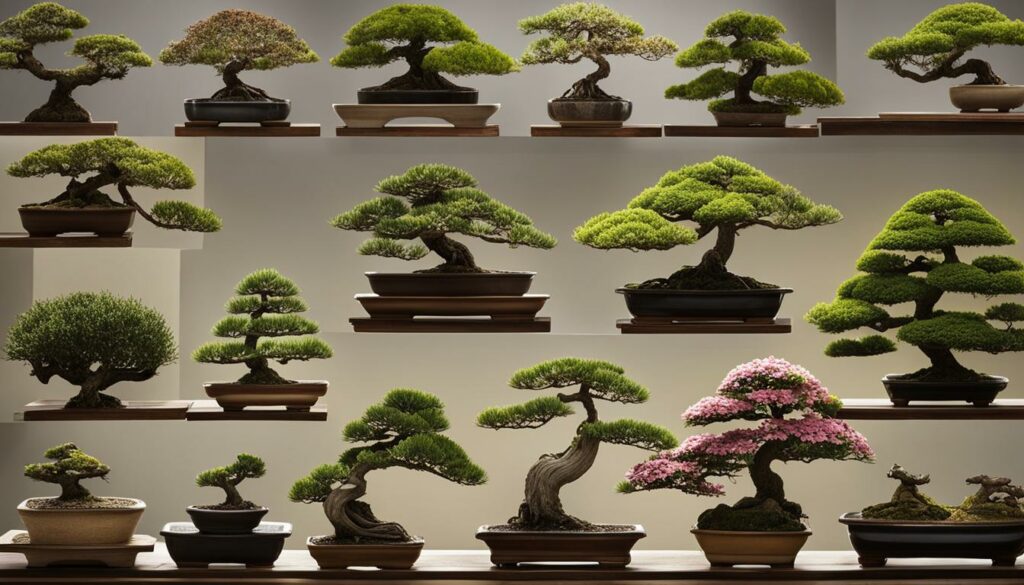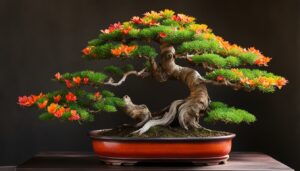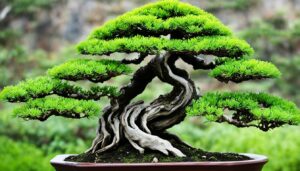If you’re looking for a new and challenging hobby that combines arboriculture, artistry, and meditative practice, then Bonsai styling might be the perfect fit for you. In this in-depth guide, we will provide a comprehensive overview of the various Bonsai styles and techniques used in shaping these exquisite miniature trees. Whether you’re a seasoned Bonsai artist or a beginner, we’ve got you covered with Bonsai styling style guides that will elevate your art.
Bonsai styling is a beautiful blend of horticulture and artistry that involves shaping and pruning trees to create visually striking, miniature representations of nature. With a history that dates back to ancient China and Japan, Bonsai styling has become a thriving art form that has evolved over centuries. From traditional approaches to modern trends, we will provide you with the knowledge and inspiration needed to create stunning Bonsai masterpieces.
Key Takeaways
- There are various Bonsai styles and techniques used in shaping these miniature trees.
- Bonsai styling is a blend of horticulture and artistry that involves shaping and pruning trees to create visually striking, miniature representations of nature.
- From traditional approaches to modern trends, we’ll provide you with the knowledge and inspiration needed to create stunning Bonsai masterpieces.
- Bonsai styling is a rewarding and meditative practice that can enrich your life in many ways.
- With the right tools, equipment, and techniques, creating beautiful Bonsai is within reach for anyone who loves nature and creativity.
Understanding Bonsai Forms
Before you start learning about styling techniques, it’s essential to understand the different forms of Bonsai. Each style has its unique characteristics and fundamental structures, defining its shape and form. Here are the six primary Bonsai forms:
| Bonsai Form | Description |
|---|---|
| Formal Upright | A straight, upward-growing style, with a tapering trunk, and branches extending progressively. |
| Informal Upright | A naturalistic, asymmetrical form, usually with the trunk bent slightly, and branches growing in different directions. |
| Slanting | A slanted, gentle curve towards one side, with branches extending vertically and diagonally up and down. |
| Cascade | A cascading form with a trunk extending downwards from the pot, with branches flowing downwards. |
| Semi-Cascade | A semi-cascading form, where the trunk extends out at the base then curves downwards, with branches a few inches above the pot. |
| Windswept | A windswept style, where the trunk curves to one side with branches growing horizontally in the opposite direction. |
Bonsai forms can determine the overall character and theme of your Bonsai. Understanding their basic structures and characteristics can guide you in selecting the appropriate species and help you appreciate the visual appeal of each form.
Classification of Bonsai Styles
Just like art, Bonsai styles are heavily influenced by cultural traditions, aesthetic principles, and regional characteristics. In this section, we will classify Bonsai styles into three categories: traditional Japanese styles, Chinese styles, and contemporary interpretations.
Traditional Japanese Styles
Traditional Japanese Bonsai styles are deeply rooted in the cultural and spiritual significance of nature and balance. These styles are often classified based on the tree’s shape, such as “formal upright,” “informal upright,” and “cascade.” The main principles of traditional Japanese Bonsai styling are simplicity, asymmetry, and minimalism.
“The fundamental spiritual experience of Bonsai is to be found in the relationship between a person and a tree.”
— Will Hiltz
Chinese Styles
Chinese Bonsai styles are characterized by their elaborate, intricate designs and focus on naturalism and refinement. Chinese Bonsai design often features small landscapes and intricate detailing. The main principles of Chinese Bonsai styling are the emulation of nature, attention to minute details, and asymmetrical balance.
Contemporary Interpretations
Contemporary Bonsai styling offers artists the opportunity to push artistic boundaries and experiment with new forms, materials, and techniques. Interpretations include abstract designs, bonsai forests, and group plantings. In contemporary Bonsai styling, the focus is on innovation, creativity, and personal expression.
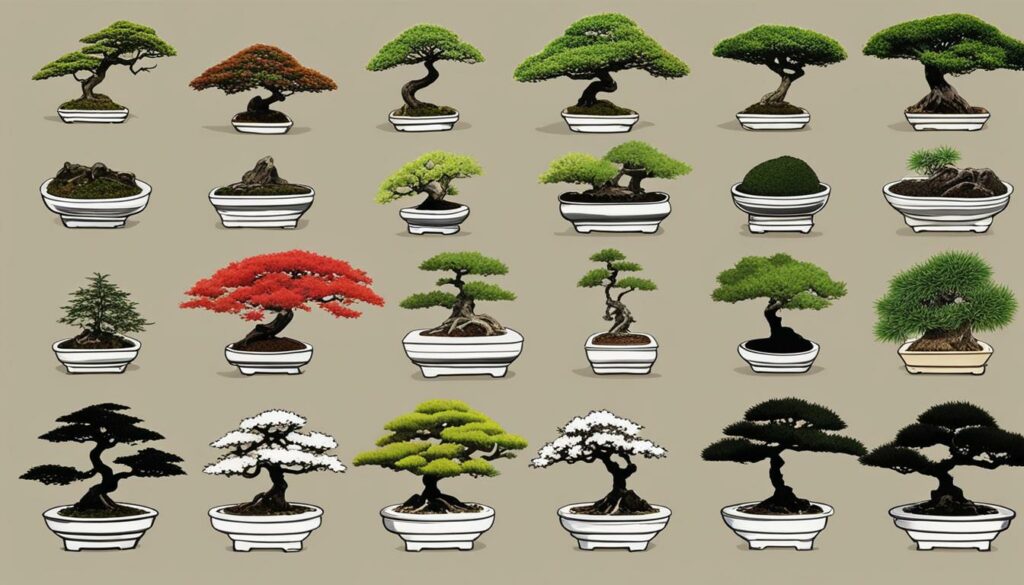
If you’re looking to develop your own unique Bonsai style, exploring each of these categories can provide you with great inspiration and insight.
Traditional Bonsai Styling Techniques
In the world of Bonsai styling, traditional techniques play a crucial role. These techniques have been developed and refined over centuries and have deep roots in Japanese culture. If you are looking to create classic, elegant Bonsai designs, understanding and utilizing these techniques are essential.
One of the primary techniques used in Bonsai styling is pruning. Pruning helps to control and shape the tree’s growth, encouraging it to form the desired shape and size.
Another essential technique is wiring, which allows you to bend and shape thin branches. Proper wiring aims to create a natural, flowing movement that adds to the tree’s overall aesthetic appeal.
Defoliation is another common technique used in traditional Bonsai styling. This technique involves removing all of the tree’s leaves, forcing it to regrow new leaves that are smaller in size. This process helps the tree to maintain its smaller size while also promoting healthy growth.
When using traditional techniques, it is vital to keep in mind the principles of proportion, balance, and harmony. These principles help to create a visually pleasing design that flows naturally, rather than appearing forced or unbalanced.
In summary, understanding and utilizing traditional Bonsai styling techniques is essential when creating classic, elegant Bonsai designs. Pruning, wiring, and defoliation are among the primary techniques used, and principles of proportion, balance, and harmony should be kept in mind when designing Bonsai.
Modern Bonsai Styling Trends
As you continue to explore the art of Bonsai styling, it’s essential to discover modern techniques that push the boundaries of traditional aesthetics. Innovative approaches have emerged, featuring abstract designs, minimalism, and experimental forms.
Modern Bonsai artists have redefined the art of Bonsai with their unique perspective and style. Many contemporary artists incorporate other art forms such as sculpture and painting, to create a distinctive showpiece.
One trend gaining popularity is incorporating unconventional materials such as metal and glass to create bases for Bonsai trees. These materials create a striking contrast to the natural beauty of the tree and add a contemporary twist to traditional styling.
Incorporating Bonsai Into Modern Home Decor
Bonsai styling provides endless opportunities to enhance your home decor. The sleek and minimalist approach of modern Bonsai styling blends seamlessly with modern home interiors, offering a unique accent piece.
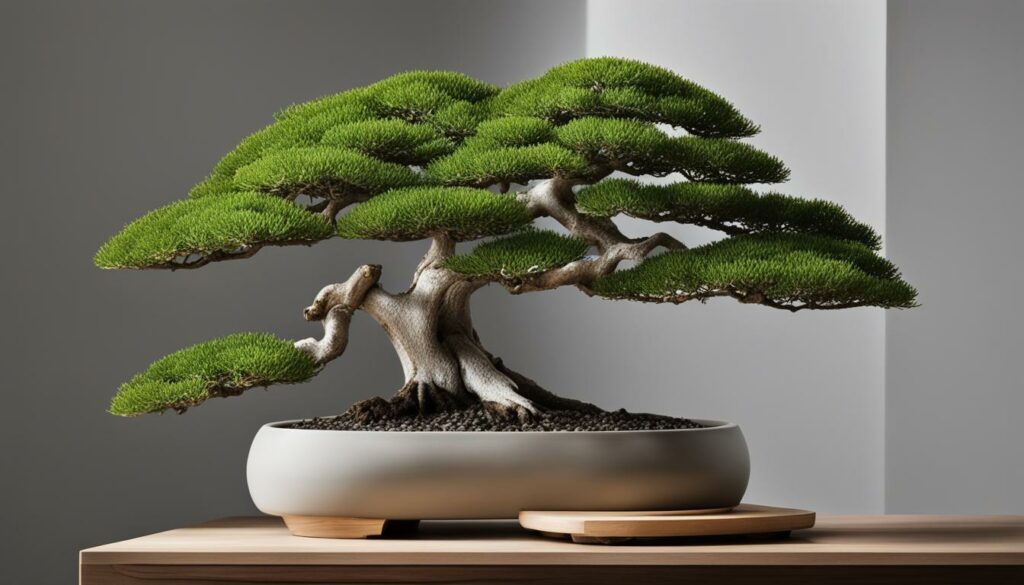
“The modern approach to Bonsai styling provides an entirely new dimension to the already captivating art form of Bonsai. From the contemporary materials to the innovative techniques, the possibilities seem endless.”
Artistic Direction in Bonsai Styling
Creating a Bonsai is not just a process of trimming and shaping a plant to a particular style. It’s also an expression of your artistic vision. Every Bonsai is unique, and you can develop your own style and creative expression through Bonsai design. When you create a Bonsai tree, there is room for you to infuse your emotions, preferences, and personal flair.
Artistic direction is essential in Bonsai design. It’s what distinguishes your Bonsai from others and reflects your individuality. Whether you are a beginner or a seasoned practitioner, exploring your artistic direction can breathe new life into your designs and inspire you to try new techniques.
For instance, storytelling is a technique that can make your Bonsai more captivating. You can create a Bonsai that tells a story and captures the imagination of those who see it. Similarly, incorporating your emotions into your designs can make your Bonsai more emotive and expressive. When you begin to explore your artistic direction, you will find that there are countless ways to bring your personal style and flair into your Bonsai creations.
Ultimately, the most satisfying thing about Bonsai design is that there are no limits to what you can create. You can let your imagination run wild and experiment with different styles and techniques until you find your unique artistic direction. So, let your inner artist out, and see where it takes you with your Bonsai styling.
Tools and Equipment for Bonsai Styling
The art of Bonsai styling requires specific tools and equipment to achieve the desired results. In this section, we’ll explore the essential tools needed for Bonsai styling and how to care for them properly to ensure optimal performance.
Pruning Shears
Pruning shears are essential for removing branches and leaves in Bonsai styling. There are two types of pruning shears: concave and knob-cutters. Concave cutters remove branches without leaving protrusions and are excellent for creating shortening branches or at those times when a clean cut is necessary. The Knob cutters, on the other hand, can only be used to trim at a specific angle.
Wire Cutters
Wire Cutters are used to trim wires used in Bonsai styling properly. The cutters should be sharp and durable to ensure clean cuts that won’t damage the tree’s bark.
Concave Cutters
Concave Cutters are used for removing branches from the tree without leaving any protrusions. Without concave cutters, it may be challenging to maintain a clean pruning cut, and it may cause further harm to the tree.
Bonsai Wire
Bonsai wire is used in the styling of Bonsai trees to help bend and shape branches. The wire should be of good quality and purpose-specific for the tree species to avoid damaging the tree’s bark.
Bonsai trees are delicate and require specific tools. Ensure that you invest in high-quality tools to safeguard your tree’s health.
Proper maintenance and care of your Bonsai styling tools are essential. Always remember to clean them after use, oil them regularly, and store them in a safe place. Following these tips will help prolong the life and effectiveness of your tools, ensuring that you can create beautiful and healthy Bonsai trees for years to come.
Selecting Suitable Tree Species for Styling
When selecting a tree species for Bonsai styling, it’s essential to consider their growth characteristics, leaf size, and adaptability to container cultivation. Not all trees are suitable for Bonsai styling, and choosing the right species is crucial for ensuring the best results for your Bonsai creations.
Some tree species have smaller leaves, making them more appropriate for Bonsai styling. Others have branches that are easy to bend and shape, making them ideal for creating different Bonsai styles. Understanding the growth habits of a tree is paramount to ensuring that it can be trained into a Bonsai design successfully.
Take into account the climate in which your Bonsai will grow. Some tree species require a specific environment and temperature range to thrive. It’s worth researching and selecting tree species that can handle the climate in which you live, ensuring that they remain healthy and abundant for many years to come.
Here are some tree species that are popular choices for Bonsai styling:
| Species | Characteristics | Bonsai Style |
|---|---|---|
| Juniper | Narrow needles, easy to shape, hardy in cold climates | Informal upright, Cascade |
| Japanese Maple | Small leaves, beautiful fall foliage, prefers shade | Informal upright, Slanting, Formal upright |
| Pine | Long needles, likes cold climates, forms multiple trunks | Informal upright, Broom, Cascade |
| Ficus | Small leaves, easy to care for, tolerant of low humidity | Informal upright, Slanting, Banyan |
Remember that each tree species presents its unique challenges and rewards. The above table presents just a few examples. Still, there are hundreds of other tree species that are suitable for Bonsai styling, and with careful consideration and research, you can create beautiful, healthy Bonsai trees.
Basic Styling Techniques for Beginners
If you’re new to the Bonsai world, you might feel overwhelmed by the variety of styling techniques. Don’t worry! We’ve got you covered. This section will teach you the basic techniques you should master first.
Bonsai Styling Style Guides
Bonsai styling has many rules, techniques, and guidelines that have developed over centuries of practice. From pruning to wiring, you will learn the necessary techniques to shape and care for your Bonsai.
Essential Techniques
The essential techniques include shaping the trunk and branches, wiring, and creating movement and balance. To shape the trunk, use branch cutters to remove unwanted growth and wire to guide the trunk and branches. Additionally, manipulating the branches’ position creates movement and balance for your Bonsai.
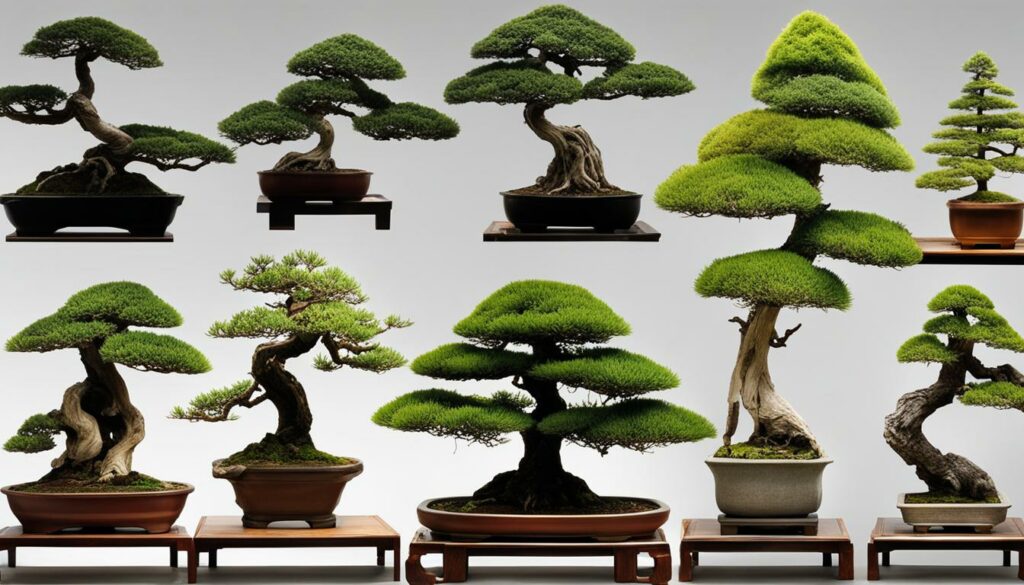
Shaping the Trunk and Branches
Shaping the trunk and branches is the most fundamental technique for beginners. Use branch cutters to cut off new shoots and lower branches to achieve the desired shape and size of the trunk. Then, wire the desired shape and position of the branches.
Wiring
Wiring is a primary technique for shaping the branches into the desired position. To avoid damaging your Bonsai while wiring, make sure the wire is not too tight or loose and remove it after a few weeks
Movement and Balance
Creating movement and balance in your Bonsai is essential to achieving a beautiful composition. Use the branch’s layout and position to create the illusion of natural movement and balance.
Remember to keep your patience, and keep creating your stunning Bonsai creation!
Advanced Bonsai Styling Techniques
As an experienced Bonsai enthusiast, you may be ready to explore advanced styling techniques that will take your creations to the next level. In this section, we will cover some advanced Bonsai styling techniques that can transform your tree into a stunning masterpiece.
Jin and Shari (Deadwood Styling)
Jin and shari are traditional Japanese techniques of deadwood styling that can create a dramatic effect in Bonsai. Jin involves removing live branches and leaving a stripped, jagged remnant that looks like a dead branch. Shari, on the other hand, involves removing a strip of bark from the trunk, which emphasizes the tree’s age and character.
Grafting
Grafting is another technique for advanced Bonsai styling. It involves fusing a branch from one tree onto another, thereby creating a unique, multi-branched Bonsai tree that showcases different colors, textures, and shapes. This technique is a skill that requires advanced knowledge of tree biology but can ultimately produce incredible results.
Carving
If you want to give your Bonsai tree a striking, distinctive feature, carving is a great technique to master. With this technique, you can create intricate designs on the tree’s bark, such as lifelike figures, animals, or symbols. It requires a steady hand and a lot of patience, but the end result is a stunning work of art.
Intricate Branch Structures
Creating intricate branch structures is another advanced technique that can take your Bonsai styling to the next level. By combining wiring, pruning, and other techniques, you can create complex branch arrangements that showcase your artistic vision and skill. Whether you choose formal, informal, or cascading styles, intricate branch structures can add depth and character to your Bonsai tree.
“Advanced Bonsai styling is a journey of self-discovery and artistic expression. With these advanced techniques, you can create Bonsai trees that reflect your unique vision and skill.”
Bonsai Styling for Different Environments
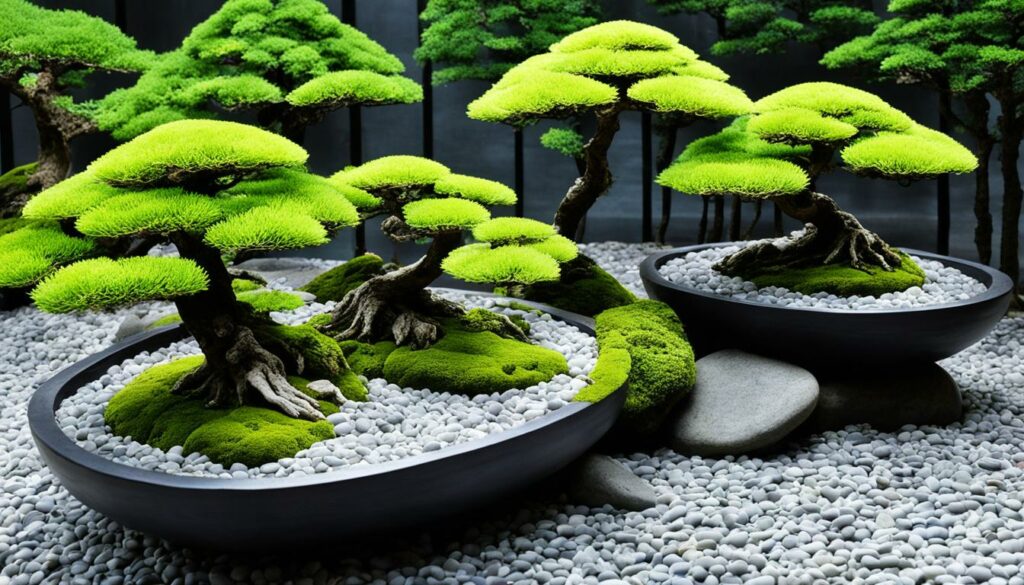
If you want your Bonsai to thrive, it’s essential to consider the environment in which you plan to display it. Indoor and outdoor Bonsai have different requirements that will affect the styling techniques you use.
Indoor Bonsai
Indoor Bonsai is a popular option for those who live in areas with harsh weather conditions. However, the indoor environment presents some challenges that must be addressed to ensure your Bonsai stays healthy.
- Light: Indoor Bonsai needs bright, indirect light to thrive. South or west-facing windows are ideal, but if you don’t have access to enough natural light, you can use fluorescent or LED grow lights to supplement it.
- Temperature: Most indoor Bonsai prefer temperatures between 60-75°F. Keep your Bonsai away from heat sources like radiators or heaters and protect it from cold drafts.
- Humidity: Indoor environments tend to be dry, which can be detrimental to Bonsai. Use a humidity tray or a humidifier to increase humidity levels around your Bonsai.
When styling indoor Bonsai, focus on species that can tolerate low light levels and require less humidity.
Outdoor Bonsai
Outdoor Bonsai can thrive in varying climates and is an excellent option for those who want to create a natural-looking Bonsai. However, outdoor Bonsai require specific care to thrive.
- Light: Outdoor Bonsai need direct sunlight to grow well. Depending on the species, they may need full sun or partial shade. Research the light requirements of your species to ensure it gets the right amount of light.
- Temperature: Outdoor Bonsai can tolerate a wide range of temperatures, but extreme weather conditions can be damaging. Protect your Bonsai from excessive heat, cold, or wind.
- Humidity: Outdoor environments are naturally humid, so you don’t need to worry about humidity levels. However, if you live in a particularly arid area, you may need to water your Bonsai more frequently.
When styling outdoor Bonsai, aim to select species that are well-adapted to your climate, and consider displaying them in a natural setting like a rock garden or a water feature.
Creating Bonsai Forests and Group Plantings
One of the most captivating representations of nature in Bonsai styling is creating forests and group plantings. This technique involves using multiple tree varieties to create a miniature forest or natural scenery, evoking the beauty of nature in a single composition.
To create harmonious compositions, it’s crucial to select tree varieties that complement each other in color, texture, and leaf size. Large and small trees should be balanced, ensuring each tree has its unique form and shape that complements the overall composition.
In arranging the trees in the group planting, it’s recommended to arrange them asymmetrically to create a natural composition. Trees should be arranged at different heights to create depth and perspective. When arranged properly, your group planting will look as if they have always grown together.
It’s essential to ensure the long-term health and balance of your Bonsai group plantings. One effective technique is root pruning, which involves cutting back roots and repotting your group planting in fresh soil. Be careful not to overwater, which can lead to root rot and other diseases common to Bonsai plants.
Pests and Diseases in Bonsai Styling
When caring for your Bonsai, it’s essential to be aware of the most common pests and diseases that can compromise the health and beauty of your miniature tree. By identifying the signs of an infestation or infection early on, you can take proactive steps to prevent further damage.
Common Pests in Bonsai Trees:
| Pest Type | Symptoms | Treatment |
|---|---|---|
| Aphids | Distorted leaves, sticky residue, yellowing foliage | Wash leaves with soapy water, use insecticidal soap, introduce natural predators (e.g., ladybugs) |
| Spider Mites | Tiny yellow or brown specks on leaves, webbing between branches | Spray with water, use insecticidal soap or oil, introduce natural predators (e.g., ladybugs) |
| Mealybugs | White powdery substance, sticky residue, distorted growth, yellowing foliage | Wash leaves with soapy water, use insecticidal soap or alcohol, introduce natural predators (e.g., parasitic wasps) |
Common Diseases in Bonsai Trees:
- Root Rot: Caused by overwatering or poor soil drainage. Symptoms include yellowing leaves, drooping branches, and foul odor.
- Leaf Spot: Caused by fungi or bacteria. Symptoms include dark spots on the leaves, premature leaf drop, and stunted growth.
- Dieback: Caused by fungal infections or environmental stress. Symptoms include wilting branches, discolored bark, and deadwood.
Prevention is key when it comes to pests and diseases in Bonsai trees. Ensure that your tree is getting adequate sunlight, water, and nutrients and avoid stressful conditions, such as extreme temperatures or improper pruning. Regularly inspect your Bonsai for signs of infestation or infection and take action promptly to prevent further damage.
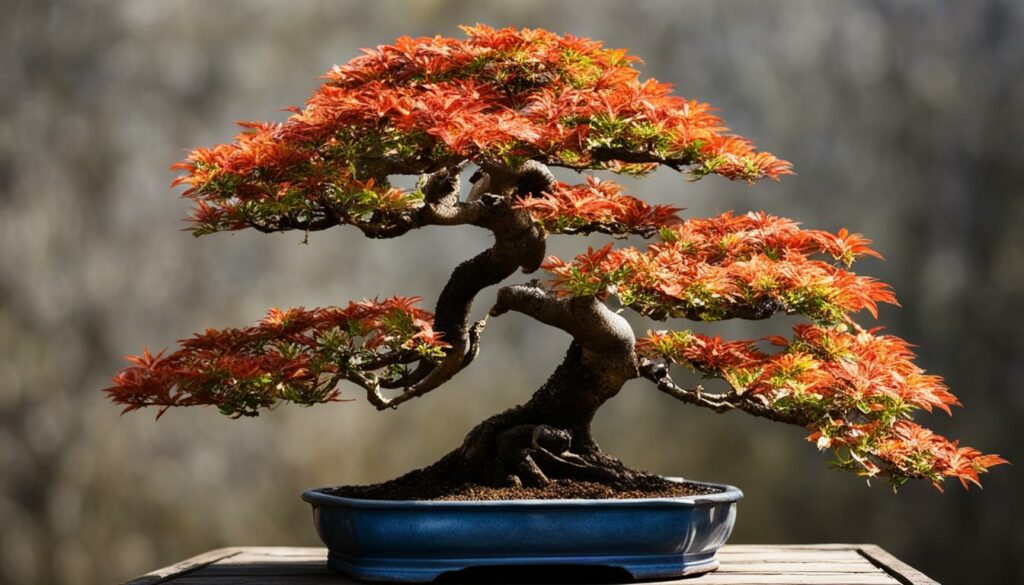
Showcasing and Displaying Your Bonsai Masterpieces
After spending time and effort perfecting your Bonsai styling skills, it’s important to showcase your creations in the best way possible. By displaying your Bonsai, you can attract attention and admiration of your work of art.
There are different display options to choose from, depending on your preference and available space. One popular choice is the traditional alcove display, which originated in Japan and involves creating a miniature landscape that complements your Bonsai. Make sure to select accessories and elements that reflect the natural elements and scenery of your Bonsai.
Another option is suiseki, which involves using natural stones to complement your Bonsai. The stones must have unique textures and patterns that match the aesthetic of your Bonsai. Additionally, bonsai stands provide an elevated platform to showcase your Bonsai, allowing viewers to appreciate its details and beauty at a closer look.
When creating a Bonsai display, it’s important to consider the overall layout and positioning of the Bonsai and accompanying elements. Ensure that the display has balance and harmony, without overcrowding or overwhelming your Bonsai. Additionally, provide enough light for your Bonsai to thrive, and avoid placing it in areas with fluctuating temperatures and humidity levels.
Conclusion
You have completed this comprehensive guide on Bonsai styling style guides. We hope that this journey has inspired you to explore the artistry of Bonsai and develop your unique style. Armed with the knowledge and techniques acquired, you are now ready to embark on your Bonsai styling adventures. Enjoy the rewarding process of bringing nature’s beauty into a miniature world.
FAQ
What are the different Bonsai forms?
The different Bonsai forms include formal upright, informal upright, slanting, cascade, semi-cascade, and windswept.
How are Bonsai styles classified?
Bonsai styles can be classified into traditional Japanese styles, Chinese styles, and more contemporary interpretations.
What are some traditional Bonsai styling techniques?
Traditional Bonsai styling techniques include pruning, wiring, and defoliation, along with principles of proportion, balance, and harmony.
Are there modern trends in Bonsai styling?
Yes, contemporary approaches to Bonsai styling include abstract designs, minimalism, and experimental forms.
How can I develop my artistic direction in Bonsai styling?
Developing artistic direction in Bonsai involves expressing your unique style, infusing emotion and storytelling, and adding personal flair to your creations.
What tools and equipment do I need for Bonsai styling?
Essential tools for Bonsai styling include pruning shears, wire cutters, concave cutters, and bonsai wire.
How do I select suitable tree species for Bonsai styling?
When choosing a tree for Bonsai styling, consider growth characteristics, leaf size, and adaptability to container cultivation.
What are some basic Bonsai styling techniques for beginners?
Beginners can learn essential techniques such as shaping the trunk and branches, wiring, and creating movement and balance.
Are there advanced Bonsai styling techniques?
Yes, advanced techniques in Bonsai styling include jin and shari (deadwood styling), grafting, carving, and creating intricate branch structures.
How do I style Bonsai for different environments?
Bonsai styling techniques can vary for indoor and outdoor environments, considering factors such as light, temperature, and humidity requirements.
How do I create Bonsai forests and group plantings?
Creating Bonsai forests and group plantings involves selecting tree varieties, arranging them aesthetically, and ensuring long-term health and balance.
How can I prevent pests and diseases in Bonsai styling?
Prevent pests and diseases in Bonsai by practicing proper care and maintenance, and taking preventive measures such as regular inspection and appropriate treatments.
How can I showcase my Bonsai masterpieces?
Showcase your Bonsai masterpieces using different display options such as traditional alcove displays, suiseki (viewing stones), and bonsai stands.
